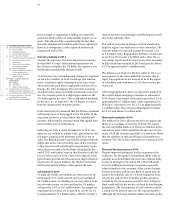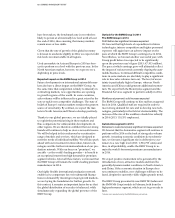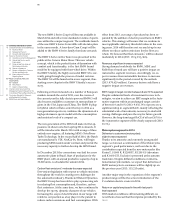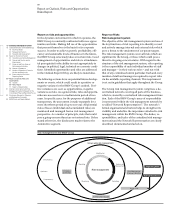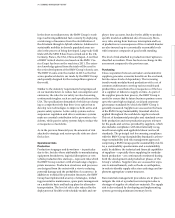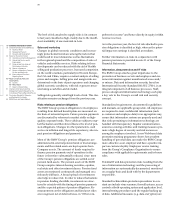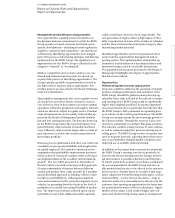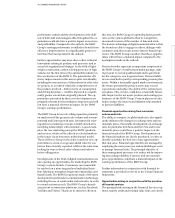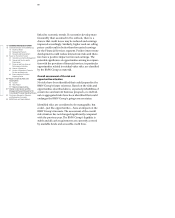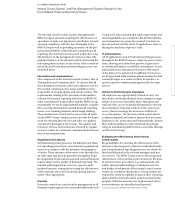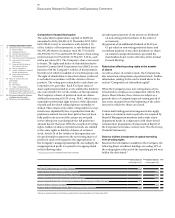BMW 2013 Annual Report Download - page 74
Download and view the complete annual report
Please find page 74 of the 2013 BMW annual report below. You can navigate through the pages in the report by either clicking on the pages listed below, or by using the keyword search tool below to find specific information within the annual report.
74
18 COMBINED MANAGEMENT REPORT
18
General Information on the BMW Group
18 Business Model
20 Management System
23 Research and Development
24 Report on Economic Position
24 Overall Assessment by Management
24 General and Sector-specific
Environment
27
Financial and Non-financial
Performance Indicators
29 Review of Operations
47 Results of Operations, Financial
Position and Net Assets
62 Events after the End of the
Reporting Period
63 Report on Outlook, Risks and
Opportunities
63 Outlook
68 Risks Report
77 Report on Opportunities
81 Internal Control System and Risk
Management System Relevant for
the
Consolidated Financial Reporting Process
82 Disclosures Relevant for Takeovers
and Explanatory Comments
85
BMW Stock and Capital Markets
metals (platinum, palladium), non-ferrous metals
(alu-
minium, copper, lead) and, to some
extent, steel and
steel ingredients (iron ore, coke / coal) are hedged using
financial derivatives. Purchase contracts with fixed
pricing
arrangements are also in place. A description
of the methods applied for risk measurement and
hedging is provided in note 42
to
the Group Financial
Statements.
Changes in the price of crude oil, as an important basic
material in the manufacture of components, have an
indirect impact on production costs. The price of crude
oil, combined with exchange rate fluctuations, also
has
an impact on fuel prices, which, in turn, directly
in-
fluence the purchasing behaviour of our customers
and
hence the overall demand for vehicles. The BMW
Group counters this risk by developing and selling highly
efficient, low-consumption engines and by developing
alternative drive technologies.
A high level of risk in the short therm is attached to
raw material risks. The potential impact on earnings is
classified as medium. The level of risk rises in the
medium term, due to the lower number of hedge trans-
actions entered into for this period.
If the relevant recognition criteria are fulfilled, deriva-
tives
used by the BMW Group are accounted for as
hedging relationships. Further information on risks in
conjunction with financial instruments is provided in
note 42 to the Group Financial Statements.
Liquidity risks
Based on experience gained during the financial crisis,
a target liquidity concept is rigorously adhered to.
Solvency is assured at all times throughout the BMW
Group by maintaining a liquidity reserve and by the
broad diversification of refinancing sources. The liquid-
ity position is monitored continuously at a separate
entity level and managed by means of a cash flow
re-
quirements and sourcing forecast system in place
throughout the Group. Liquidity risks can arise in the
form of rising refinancing costs on the one hand and
restricted access to funds on the other. The major part
of the Financial Services segment’s credit financing
and lease business is refinanced on capital markets.
Thanks to its excellent creditworthiness, the BMW
Group has good access to financial markets and, as in
previous years, was able to raise funds at good con-
ditions in 2013, reflecting a diversified refinancing
strategy and the solid liquidity base of the BMW Group.
Internationally recognised rating agencies have addi-
tionally confirmed the BMW Group’s strong creditwor-
thiness.
Similar to the previous year, both the level of risk and
the potential impact of illiquidity on earnings are clas-
sified as low – including the risk of the BMW Group’s
rating being downgraded and any ensuing deterioration
in financing conditions.
If the relevant recognition criteria are fulfilled, deriva-
tives used by the BMW Group are accounted for as
hedging relationships. Further information on risks in
conjunction with financial instruments is provided in
note 42 to the Group Financial Statements.
Risks relating to the provision of financial services
The main categories of risk relating to the provision of
financial services are credit and counterparty risk, re-
sidual value risk, interest rate risk, liquidity risk and
operational risk. In order to evaluate and manage these
risks, a variety of internal methods has been developed
based on regulatory environment requirements
(such
as
Basel II / III) and which comply with both national and
international standards.
A set of strategic principles and rules derived from regu-
latory requirements serves as the basis for risk manage-
ment
within the Financial Services segment. At the
heart of the risk management process is a clear division
between front- and back-office activities and a compre-
hensive internal control system.
The key risk management tool employed within the
Financial Services segment is aimed at ensuring that
the Group’s risk-bearing capacity is not exceeded. In
this context, all risks defined as “unexpected losses”
must be covered at all times by an appropriate asset
cushion in the form of equity capital. Unexpected losses
are measured using a variety of value-at-risk techniques,
adapted to each relevant risk category. Risks are aggre-
gated after taking account of correlation effects. The to-
tal sum of risks calculated in this way is then compared
with the resources available to cover risks (asset cush-
ion).
The segment’s risk-bearing capacity is monitored
continuously with the aid of an integrated limit system
which also differentiates between the various risk cate-
gories. The segment’s total risk exposure was covered at
all times during the past year by the available risk-cover-
age volumes.


